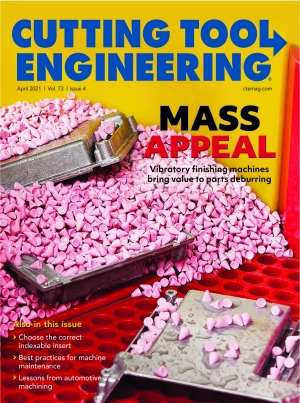Billed as an entry-level version of a feature-rich centerless grinder, a new machine is designed to provide slide motion control and other key ingredients to grinding success at a lower price point.
Developed by Glebar Co. in Ramsey, New Jersey, the GT-610 EZ costs 15% less than the company’s GT-610 grinder.
“We wanted to incorporate elements from our more sophisticated automated machines in a more affordable package for the shop that just wants to do basic through-feed grinding,” said Chief Technology Officer John Bannayan.
The EZ has four axes of motion compared with at least five offered by its higher-end counterpart. Another difference is that the position of the EZ’s regulating wheel is controlled manually, which he said makes setup easier. With a footprint measuring just 1,041 mm × 1,270 mm (41"×50"), he said the EZ also takes up much less floor space than its competitors.

Glebar says the GT-610 EZ provides some of the key capabilities of higher-end centerless grinders but costs significantly less. Image courtesy of Glebar
Equipped with a 15-hp main spindle motor, which Bannayan said is unusual for such a small machine, the EZ is suitable for grinding components under 25 mm (1") in diameter. He said people who need to take a lot of material off large-diameter components must opt for a much larger machine with a 20-hp motor.
Although grinding parts with complex geometries requires a GT-610, he said diameter reduction or producing simple geometries, such as chamfers on drill blanks, are ideal applications for the EZ. He said the new machine can reduce rods made of hard materials like steel, carbide, diamond, PCD and technical ceramics to small diameters while holding tight tolerances.
Despite being economical, the EZ features a wide 203 mm (8") grinding wheel.
“In applications where you are grinding carbide,” Bannayan said, “the more wheel you have, the fewer passes you have to take.”
Other features that also are offered by the GT-610 include spindles held by two sets of bearings.
With these twin-grip spindles, Bannayan said, “you have a much stiffer setup, so you can control your diameter much better.”
Another feature is a granite machine bed.
“The older version of the GT-610 was built on a cast-iron bed, which flexes and is not stiff enough to handle carbide tool tolerances,” Bannayan said. “With a granite base, you have much better rigidity and stiffness than you would on cast iron and also better vibration-dampening characteristics.”
Like the GT-610, the EZ is equipped with glass scales that provide submicron slide feedback for better wheel positioning. In addition, the EZ allows connection to gauges for automatic size compensation.
“You can take a gauge that’s used on the (shop) floor and plug it into a USB port on the machine for automatic diameter compensation,” Bannayan said. “So if you are grinding a particular diameter and you want to compensate by a couple of tenths, this takes the operator out of the equation.”
Developed by Glebar, the EZ’s control software can be customized to suit different applications and processes. Among other things, the control system enables remote monitoring of the machine when vibration and temperature monitors are placed on the spindles.
“We can remotely diagnose (problems) in all of our machines,” Bannayan said, “but now we can also diagnose anything on a manual machine.”
EZ users also have the option of connecting to Glebar Advanced Analytics, a cloud-based system that collects data from Glebar machines, interprets and synthesizes the data and delivers actionable real-time analytics to operators and managers via easy-to-read dashboards. He said Glebar Advanced Analytics now can provide basic overall equipment effectiveness data, such as machine uptime and downtime.
“The objective,” Bannayan said, “was to get a manual machine into (the GT-610) family from a control and data acquisition standpoint and let users leverage OEE information.”
Contact Details
Related Glossary Terms
- ceramics
ceramics
Cutting tool materials based on aluminum oxide and silicon nitride. Ceramic tools can withstand higher cutting speeds than cemented carbide tools when machining hardened steels, cast irons and high-temperature alloys.
- grinding
grinding
Machining operation in which material is removed from the workpiece by a powered abrasive wheel, stone, belt, paste, sheet, compound, slurry, etc. Takes various forms: surface grinding (creates flat and/or squared surfaces); cylindrical grinding (for external cylindrical and tapered shapes, fillets, undercuts, etc.); centerless grinding; chamfering; thread and form grinding; tool and cutter grinding; offhand grinding; lapping and polishing (grinding with extremely fine grits to create ultrasmooth surfaces); honing; and disc grinding.
- grinding wheel
grinding wheel
Wheel formed from abrasive material mixed in a suitable matrix. Takes a variety of shapes but falls into two basic categories: one that cuts on its periphery, as in reciprocating grinding, and one that cuts on its side or face, as in tool and cutter grinding.
- polycrystalline diamond ( PCD)
polycrystalline diamond ( PCD)
Cutting tool material consisting of natural or synthetic diamond crystals bonded together under high pressure at elevated temperatures. PCD is available as a tip brazed to a carbide insert carrier. Used for machining nonferrous alloys and nonmetallic materials at high cutting speeds.
- stiffness
stiffness
1. Ability of a material or part to resist elastic deflection. 2. The rate of stress with respect to strain; the greater the stress required to produce a given strain, the stiffer the material is said to be. See dynamic stiffness; static stiffness.









